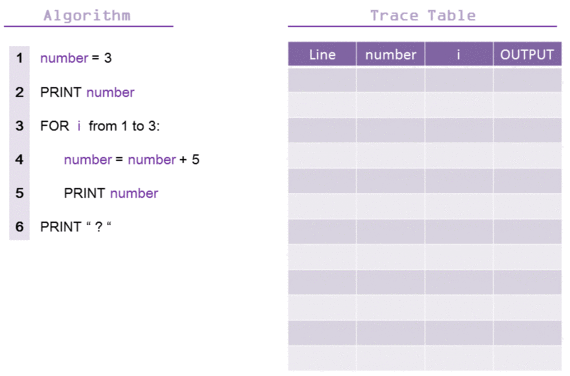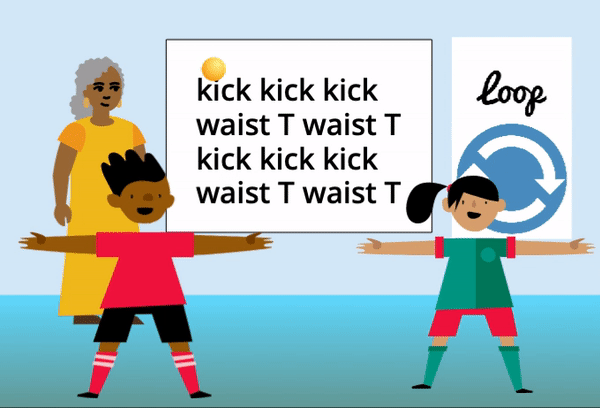Learning
Styles
Visuals for CSL
 https://www.101computing.net/using-trace-tables/
https://www.101computing.net/using-trace-tables/
A trace table for reading code is akin to a graphic organizer. Students write down the values on paper as they work through the code. Code tracing improves code reading by 15% on exams and reduces frustration [14].
Blocks-based coding, a visual language, is described by students as easier to read, easier to write due to the interlocking connection of shapes and browsability of options(natural word wall), and such programs have visual outcomes making it easier to discern the success or failure of the program [13].
Visuals for EML
.png?v=1627386315527)
Researchers found EMLs are more likely to actively participate when visuals are used as part of the lesson [4]. Vocabulary can be made visual for EMLs through visual word walls, quick drawings, graphic organizers, visual labels, pointing at objects [3], or even student created visual dictionaries [17].
Teachers can make their speech easier for EMLs to understand by gesturing while speaking to create a visual representation of their words[16]. Gesturing while speaking mimics the way we teach young children language [15].
Auditory for CSL
.png?v=1627391392426)
Early readers naturally read aloud, and the brain synapses responsible still fire during silent reading [8]. Some research shows students are better able to remember code after echoing code read aloud [7]. In one study, students who read code aloud with fluency showed higher levels of code comprehension [8].
Teachers can enhance the experience for auditory learners by incorporating sound into CS projects. Pair programming, whereby students work together on a project with a classmate in predefined roles, increases auditory learning because pairs must communicate about code to complete a task [16].
Auditory for EML
.png?v=1627390205716)
EMLs need targeted instruction in phonemic and phonetic awareness. Creating certain sounds in the target language will be difficult if that sound does not exist in the first language. [1]. Students should listen to a word and then echo that word several times [1]. Opt for choral echoing as EMLs in the silent or emerging stage will be nervous to speak aloud individually for fear of committing errors in the new language [3].
Teachers can help students process auditory language by speaking slowly and with simple, yet grammatically correct language. Teachers can provide more speaking and listening opportunities through collaborative work with peers [16].
Tactile for CSL
.png?v=1627388638786)
The power of physical computing in CS education comes from constructivist theory, which states that learning occurs when the pupil is engaged in a tangible, visible activity [11]. Physical computing may take the form of microcontrollers, robotics, and e-textiles. A meta-analysis of robotics in CS education found physical computing with robots led to greater interest in future CS courses as opposed to traditional digital-only methods [12]. Physical computing has also shown to raise levels of interest in CS in traditionally underrepresented populations [12], and specifically those who expressed a disinterest in science or computer science [10].
Tactile for EML
.png?v=1627389414105)
Manipulatives are used in mathematics to reduce the cognitive load of holding onto various numbers and operations in working memory. However, manipulatives are not just used in the mathematics classroom. Manipulatives like counters, magnetic letters, and cards are excellent tools to support EMLs [3]. Objects can create another tactile learning experience for EMLs. Allow students to touch the objects they are learning about. For example, if students are learning about the parts of a plant, allow them to touch the stem and the roots [6]. If students are learning about describing words like smooth and rough, allow them to touch smooth and rough objects [5].
Kinesthetic for CSL
 inspired by code.org
inspired by code.org
Unplugged lessons teach computing concepts without the use of a computer. They take the form of role-playing or games. Students show prolonged active engagement in lessons with unplugged activities and better retain information, being able to recall the exact details of the experience weeks later. Unplugged activities are successful when students do not have a solid foundation of the concept being taught.[9].
Kinesthetic for EML
.png?v=1627394462761)
Acting can be used by the teacher and/or students for vocabulary [2]. A more intense format of acting would be Readers Theater, which is a dynamic way for EMLs to practice reading, fluency, and comprehension of a text because practicing for the performance means repeated exposure to the same piece of writing [1].
Total Physical Response (TPR) is a teaching method where words are paired with physical movement designed by the students. As with other kinesthetic strategies, some students, especially students in the silent period, might be uncomfortable using this strategy at first [15].
CSL && EML
Research has found a match between teaching style and students' preferred learning style (visual, auditory, kinesthetic) increases academic performance [18]. Teachers should plan each lesson to benefit multiple learning styles to ensure reaching all learners.
Visual Glossary for CS
Visuals and symbols can be used to reduce cognitive load. Consider creating a visual glossary of terms in your classroom, which would be accessible for all learners. MakeCode's micro:bit tutorials come with a translator and a visual dictionary to help EMLs process the language
Organize Information
Allow students to plan programs using drawings, acting, or manipulatives like Legos [17]. Use graphic organizers for concepts and teach trace tables. MakeCode has a debugger that will step students through the code and keep track of the variables.
Embed Physical Computing
Physical computing has been shown to increase engagement for underrepresented groups. When introducing physical computing components with EMLs, allow them to touch the components. Organize the materials with visual & verbal labels so EMLs can begin matching the word with the object.